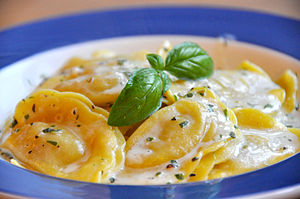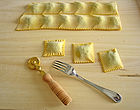Ravioli
 Ravioli with creamy sauce | |
| Type | Pasta |
|---|---|
| Place of origin | Italy |
| Region or state | Central Italy, Northern Italy |
| Main ingredients | Flour, eggs, water, filling |
Ravioli (Italian pronunciation: [raviˈɔli]; singular: raviolo, pronounced [raviˈɔlo]) are a type of pasta comprising a filling enveloped in thin pasta dough. Usually served in broth or with a sauce, they originated as a traditional food in Italian cuisine. Ravioli are commonly square, though other forms are also used, including circular and semi-circular (mezzelune).
History
The earliest known mention of ravioli appears in the personal letters of Francesco di Marco Datini, a merchant of Prato in the 14th century.[1] In Venice, the mid-14th-century manuscript Libro per cuoco offers ravioli of green herbs blanched and minced, mixed with beaten egg and fresh cheese, simmered in broth and seasoned with "sweet and strong spices".[2] In Rome, ravioli were already well-known when Bartolomeo Scappi served them with boiled chicken to the papal conclave of 1549.[3]
Ravioli were already known in 14th century England, appearing in the Anglo-Norman vellum manuscript Forme of Cury under the name of rauioles.[1][4] Sicilian ravioli and Malta's ravjul may thus be older than North Italian ones.[citation needed] Maltese ravjul are stuffed with irkotta, the locally produced sheep's-milk ricotta, or with gbejna, the traditional fresh sheep's-milk cheese.

Overview

Traditionally, ravioli are made at home. The filling varies according to the area where they are prepared. In Rome and Latium the filling is made with ricotta cheese, spinach, nutmeg and black pepper. In Sardinia, ravioli are filled with ricotta and grated lemon rind.
Modern ravioli are also mass-produced by machine.[5]
Around the world
In Europe and the United States, fresh-packed ravioli have several weeks of shelf life. Canned ravioli were pioneered by the Italian Army in the First World War and were popularized by Heinz and Buitoni in the UK and Europe, and Chef Boyardee in the United States. Canned ravioli may be filled with beef, processed cheese, chicken, or Italian sausage and served in a tomato, tomato-meat, or tomato-cheese sauce. Toasted ravioli (ravioli that have been breaded and deep fried) was developed in St. Louis, Missouri, and is a popular appetizer and snack food.[6]
Ravioli are commonly encountered in the cooking of Nice, the broader Côte d'Azur, and the surrounding regions in the south of France. The contents of these vary greatly, but most idiosyncratic to the region is the use of leftover daube meat.[7] Miniaturized cheese-filled ravioli, locally called ravioles, are a specialty of the Drôme department in the Rhône-Alpes region, particularly the commune of Romans-sur-Isère, and are frequently served au gratin.
Ravioli filled with halloumi are a traditional pasta dish of Cypriot cuisine.[8] They are boiled in chicken stock and served with grated halloumi and dried mint on top.
In other cultures
In Turkey, Mantı which is similar to ravioli is a popular dish. It is stuffed with spiced meat and served with paprika sauce and yoghurt. Similar dishes in China are the jiaozi or wonton.
In India, a popular dish called gujiya is similar to ravioli. However, it is prepared sweet, with a filling of dry fruits, sugar, and a mixture of sweet spices, then deep fried in vegetable oil. Different stuffings are used in different parts of India. The dish is a popular food prepared during festivals all over the country.
Jewish cuisine has a similar dish called kreplach, a pocket of meat or other filling, with an egg pasta based covering. It is simmered in chicken soup. In that method of preparation it appears to be the direct descendant or inspiration of the original dish, which was simmered in "broth". Claudia Roden argues it originated in the Venetian Ghetto at about the same time ravioli was developed, and in time became a mainstay of Jewish cuisine.[citation needed]
A similar Middle Eastern dish called shishbarak contains pasta filled with minced beef meat and cooked in hot yogurt.
See also
- Agnolotti
- Baozi
- Gnocchi
- Italian cuisine
- Khinkali
- List of dumplings
- List of Italian dishes
- Mandu
- Mantı
- Mataz
- Maultasche
- Modak / Kozhakkattai
- Momo (food)
- Pelmeni
- Pierogi
- Samosa
- Tortellini
References
Notes
- ^ Jump up to: a b Davidson Oxford Companion to Food, p. 655.
- ^ Dickie Delizia, p. 55.
- ^ Dickie Delizia, p. 11
- ^ Adamson Regional Cuisines, p. 25.
- ^ Madehow.com, How Products are Made, "Pasta".
- ^ Smith. Oxford Companion to American Food. p. 386.
- ^ Wolfert. Mediterranean Clay Pot Cooking. p. 176.
- ^ "Ravioli (translated)". Cyprus Virtual Food Museum. Retrieved 15 October 2019.
Sources
- Adamson, Melitta Weiss; ed. (2002) Regional Cuisines of Medieval Europe: A Book of Essays. Routledge. ISBN 0-415-92994-6.
- Davidson, Alan, ed. (1999). The Oxford Companion to Food. Oxford University Press. ISBN 978-0-192-11579-9.
- Dickie, John (2008). Delizia! The Epic History of the Italians and Their Food. Free Press. ISBN 978-0-7432-7799-0.
- McNulty, Mary F. "Pasta". How Products are Made. Madehow.com. Retrieved 1 September 2013.
- Smith, Andrew F., ed. (2007). The Oxford Companion to American Food and Drink. Oxford University Press. ISBN 978-0-19-530796-2. Retrieved 5 September 2012.
- Wolfert, Paula (2009). Mediterranean Clay Pot Cooking: Traditional and Modern Recipes to Savor and Share. Hoboken, N.J.: John Wiley & Sons. p. 176. ISBN 978-0-764-57633-1.
External links
| Wikimedia Commons has media related to Ravioli. |
| Look up ravioli in Wiktionary, the free dictionary. |
| Wikibooks has a book on the topic of: Cookbook:Ravioli |
- How to make ravioli from scratch (video)
- General catalog of double sheet ravioli shapes
- Machine-made ravioli (video), commercial demonstration of machine producing different kinds of pasta, including ravioli
- Pasta dishes
- Dumplings
- Italian cuisine
- French cuisine
- Maltese cuisine
- Cypriot cuisine